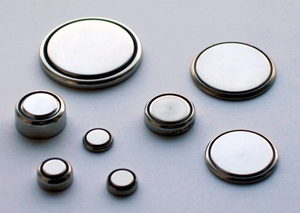4 November 2014. Engineers and medical researchers at Massachusetts Institute of Technology and hospitals affiliated with Harvard Medical School developed a coating for small batteries that tests show could prevent poisoning when swallowed accidentally by young children. The team from the labs of Robert Langer at MIT and Jeffrey Karp at Brigham and Women’s Hospital in Boston published its findings yesterday in Proceedings of the National Academy of Sciences (paid subscription required).
Button batteries power small electronic devices like watches and toys, and are made from compacted metals and metal oxides divided by a separator infused with electrolytes. Regulations and standards requiring locked battery compartments reduced somewhat the number of accidental ingestions of button batteries in 2013 to 3,366. But a swallowed button battery can cause choking, tissue wounds in the esophagus, and chemical burns from electricity generated by the battery.
The researchers aimed for a solution that makes button batteries safer for children if accidentally swallowed, yet still work normally when installed in electronic devices. Their investigations led to an inexpensive material used today in electronics known as quantum tunneling composites that can switch from insulator to conductor when force is applied.
Quantum tunneling composites are rubber-like polymers filled with metal fibers that in their normal state are too far apart to conduct a current. But when compacted, the fibers come into contact, conducting the electrons in a phenomenon called quantum tunneling. This response to pressure makes quantum tunneling composites useful for keyboards and touch screens.
Inside electronic devices, button batteries are compacted and thus in a somewhat pressured state. The team hypothesized a coating of quantum tunneling composites on button batteries would respond to this normal pressure inside a device and enable the batteries to produce a current. Yet inside a child’s esophagus or gastrointestinal tract the battery would not be under pressure and thus would not produce a current that burns.
The researchers calculated the amount of force generated by peristalsis, the muscle contractions moving food through the digestion process, and found the pressure produced by peristalsis, even under extreme conditions, was not enough to produce a current on a coated button battery. They then tested a coated button battery in the esophagus of a pig, and found no evidence of damage to the animal. In addition, their tests show coated button batteries operate normally inside electronic devices.
“We think this is a relatively simple solution,” says Karp in an MIT statement, “that should be easy to scale, won’t add significant cost, and can address one of the biggest problems associated with ingestion of these batteries.” The researchers are working on methods that manufacturers can adopt to produce coated batteries and are seeking industry partners.
Read more:
- New Coating Material Stops Blood Clots, Bacterial Films
- Chip Emulates Human Airway Muscles to Test Asthma Treatments
- More Efficient Growth Factor Delivery Technique Devised
- Trial Shows Polymer Dressing Reduces Surgical Scarring
- Electronic Circuits Developed That Become Flexible in Body
* * *


 RSS - Posts
RSS - Posts
You must be logged in to post a comment.